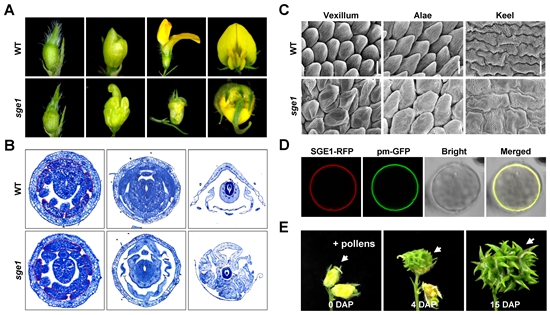ABCG Transporters SGE1 and MtABCG13 Control Stigma Exsertion in Medicago Truncatula
Stigma exsertion is an important agricultural trait that facilitates the use of heterosis in crop breeding. Although several quantitative trait loci associated with stigma exsertion have been fine mapped or cloned, the underlying genetic basis, particular in legumes, remains unclear. In this study, we identified and characterized an exserted stigma mutant stigma exsertion 1 (sge1) in the model legume Medicago truncatula. The exserted stigma phenotype of sge1 is mainly caused by physical interaction between floral organs, in which normal petal and stamen elongation are inhibited due to flower cuticle defects. SGE1 encodes an ATP binding cassette G transporter (ABCG) that plays a critical role in regulating floral cutin and wax secretion in M. truncatula. SGE1 physically interacts with another half-size transporter, MtABCG13, to form a functional heterodimer. Mutation of MtABCG13 results in flower cuticle defects similar to those in sge1, as well as stigma exsertion, indicating that SGE1 and MtABCG13 are indispensable for flower cuticle secretion and collaboratively control stigma exsertion in M. truncatula. Our findings uncover novel functions for ABCG transporters in determining stigma exsertion by affecting the physical interactions of floral organs, providing insight into the molecular mechanism underlying stigma exsertion in leguminous plants with complex zygomorphic flowers.

By Lin Hao (linhao@caas.cn)
-
 Apr 18, 2024Opening Ceremony of the Training Workshop on Wheat Head Scab Resistance Breeding and Pest Control in Africa Held in CAAS
Apr 18, 2024Opening Ceremony of the Training Workshop on Wheat Head Scab Resistance Breeding and Pest Control in Africa Held in CAAS -
 Apr 03, 2024IPPCAAS Co-organized the Training Workshop on Management and Application of Biopesticides in Nepal
Apr 03, 2024IPPCAAS Co-organized the Training Workshop on Management and Application of Biopesticides in Nepal -
 Mar 28, 2024Delegation from the School of Agriculture and Food Science of University College Dublin, Ireland Visit to IAS, CAAS
Mar 28, 2024Delegation from the School of Agriculture and Food Science of University College Dublin, Ireland Visit to IAS, CAAS -
 Mar 25, 2024Director of World Food Prize Foundation visited GSCAAS
Mar 25, 2024Director of World Food Prize Foundation visited GSCAAS -
 Mar 20, 2024Institute of Crop Sciences (ICS) and Syngenta Group Global Seeds Advance Collaborative Research in the Seed Industry
Mar 20, 2024Institute of Crop Sciences (ICS) and Syngenta Group Global Seeds Advance Collaborative Research in the Seed Industry
